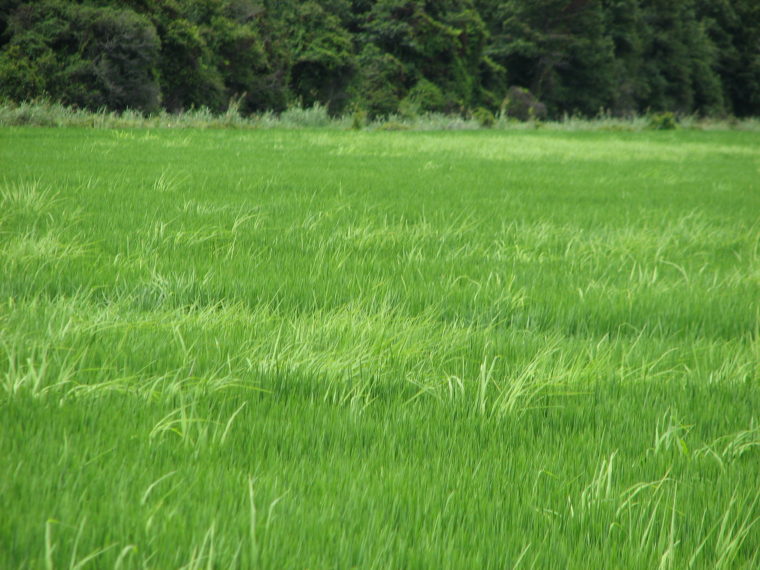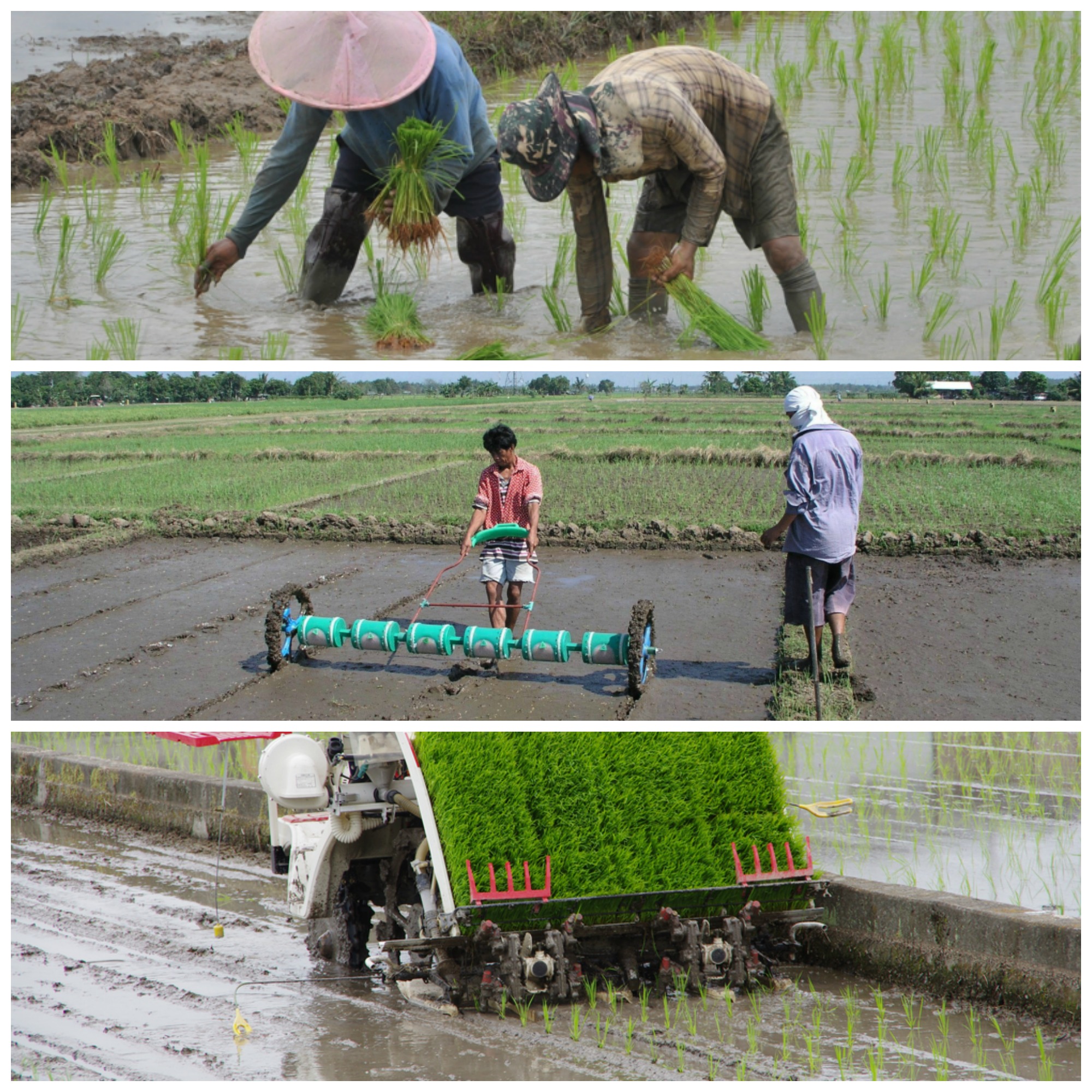St. Louis, Missouri, USA
April 3, 2017
 Weedy rice (the taller plants) is outgrowing and outcompeting crop rice in this Arkansas field. Credit: Ken Olsen
Weedy rice (the taller plants) is outgrowing and outcompeting crop rice in this Arkansas field. Credit: Ken Olsen
A new study in the April 3 issue of Nature Genetics describes an ancestry.com-type adventure that reveals the deep history of a family, including some disreputable relatives. But the family in this case is Asian rice (Oryza sativa), and the disreputable relatives are the weedy cousins of domesticated rice.
Weedy rice is neither wild rice nor crop rice but rather formerly domesticated rice that has shed some traits important to people. Adapted to human coddling, it does not grow outside of agricultural fields, but at the same time, it is not easily harvested and produces unpalatable seeds.
Depending on where you are in the world, the reduction in yield of crop rice can be as high as 90 percent because of these weeds, said Kenneth Olsen, professor of biology at Washington University in St. Louis and the lead author on the paper. Even in the U.S., weedy rice is estimated to be present in 30 percent of rice fields and leads to crop losses of more than $50 million annually.
There are two major strains of weedy rice in the U.S.: strawhull and blackhull awned. (Awns are the long bristles that give some grasses a hairy appearance). Because the two weedy strains evolved independently, they provide an ideal opportunity to study the genetic basis of weediness and, particularly, whether it always arises through the same genetic mechanism.

Seeds of blackhull awned weedy rice. Credit: Ken Olsen
For this purpose, a team of scientists from China and the U.S. — including Washington University — sequenced the genomes of 18 strawhull weeds and 20 blackhull weeds and compared them to 145 previously published genomes of crop and wild varieties of rice.
Analysis showed that: the two weeds evolved from two different crop varieties; they evolved at different stages in the domestication process; and the genetic basis for weediness differs between the strains. It also revealed that, in both cases, relatively few changes were needed to turn the crop plant into a weed.
Rice, in other words, has a proclivity toward weediness. “It’s easy to evolve weediness, and it has happened repeatedly,” said Olsen.
No more stoop labor
“The evolution of weedy crop relatives is an under-recognized part of the domestication process,” Olsen continued. “Until recently, few of those studying domestication had given much thought to these weedy doppelgangers that were just kind of persisting on the margins of fields.”
 Different methods of planting rice put different selection pressures on rice, some more favorable to weedy rice than crop rice. From top to bottom: hand planting; direct seeding; and mechanized planting of seedlings. Credit, from top to bottom: Shutterstock; International Rice Research Institute; Shutterstock.
Different methods of planting rice put different selection pressures on rice, some more favorable to weedy rice than crop rice. From top to bottom: hand planting; direct seeding; and mechanized planting of seedlings. Credit, from top to bottom: Shutterstock; International Rice Research Institute; Shutterstock.
When rice is planted by hand, each seedling is scrutinized and weedy ones discarded. But the adoption of mechanized, direct-seeded farming has changed the equation. “The weedy relatives look so much like the crop, they blend in and farmers don’t realize they have a problem until they have a real infestation,” Olsen said.
One of the most noticeable weedy traits is highly shattering seeds. “When cereal crops were domesticated, people selected against shattering because it made the grain easier to harvest, but if you’re a weedy species you want to disperse seed. So with the weedy strains there’s a re-emergence of seed shattering,” Olsen explained.
Weeds also have very persistent seed dormancy, he said. During domestication, there’s selection against dormancy, because farmers select for whatever comes up first. But, again, that’s a bad strategy for a weed, so dormancy re-emerges as well.
The combination of shattering and prolonged dormancy means there is a reservoir of weed seeds in crop fields that can come up year after year and outcompete the crop.
Deep history of rice
The genetic analysis undertaken by the team of scientists showed that the two strains of weedy are descended from two separate rice varieties, indica and aus, which were domesticated in different parts of Asia.
Most of the rice grown in the U.S. is a third variety, japonica, domesticated in yet another location. For this reason, and because there is comparatively little genetic diversity in the two weedy strains, they were probably introduced to the U.S. as contaminants in grain stocks.
Both weedy strains evolved after rice was domesticated and after some varietal differences had emerged in the crop. But the blackhull weed seems to have diverged from the aus variety of rice much earlier than the strawhull weed diverged from indica.
Crop domestication is a long process usually divided into two stages, Olsen explained. During the first stage, human selection favors “domestication traits” that allow the plant to be cultivated in the first place, such as seedheads that don’t shatter easily. Later, human selection favors “improvement traits,” such as the popcorn-like aroma and flavor of basmati rice.
The more of these traits a weedy strain possesses, the later it evolved. Both the U.S. weed strains have only the crop variants of three genes that are targets of selection during rice domestication. On the other hand, the strawhull but not the blackhull weedy variety has the genes for most of the widely selected improvement traits.
The blackhull weeds evolved after rice was domesticated but before it was improved, and the strawhull weeds spun off only after rice had been further improved by selection
De-domestication
Having established when weediness evolved, the scientists looked at how it had evolved by comparing the genomes of the weedy varieties to those of their inferred crop ancestors. They were searching for “signatures of selection,” evidence of mutations so favorable they spread rapidly through a population.
What they found is that the signatures corresponded to regions of the genome that control weedy traits but not to those affected by domestication. For example, all the weedy rices possess the sh4 mutation that characterizes domesticated non-shattering rices. Eight other gene regions, however, are implicated in the re-acquisition of shattering by the weedy strains.
Moreover, most of the genes for weed adaptation are clustered in genomic islands rather than randomly distributed throughout the genome.
“It’s different genomic islands in each weed type,” Olsen said. “So changing a crop into a weed doesn’t take many genetic changes and it can occur through different genetic mechanisms.”
“We should keep in mind the apparent ease with which these agricultural weeds have repeatedly evolved as we shift toward mechanized production practices that promote their success.”
“What I find fascinating about these weeds,” Olsen said, “is the way they’ve co-opted the agricultural system. They take advantage of this wonderful environment we’re creating by tilling and providing nutrients, and way outcompete the plants that have desirable traits.”
This research was funded by the National Science Foundation Plant Genome Research Program (IOS-1032023).